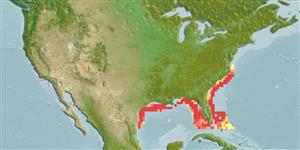Common names from other countries
>
Eupercaria/misc (Various families in series Eupercaria) >
Latilidae (Deepwater tilefishes)
Etymology: Caulolatilus: Greek, kaulos = stem, stalk + Latin, latus = wide (Ref. 45335).
More on authors: Goode & Bean.
Environment: milieu / climate zone / depth range / distribution range
Écologie
marin démersal; profondeur 30 - 162 m (Ref. 8991). Subtropical; 37°N - 24°N, 98°W - 75°W
Western Atlantic: North Carolina to southern Florida in USA and Mexico; also in northern and probably eastern Gulf of Mexico.
Taille / Poids / Âge
Maturity: Lm ? range ? - ? cm
Max length : 90.0 cm TL mâle / non sexé; (Ref. 7251); common length : 55.0 cm TL mâle / non sexé; (Ref. 3276); poids max. publié: 7.0 kg (Ref. 3276); âge max. reporté: 15 années (Ref. 6134)
Occurs on mud and rubble bottom. Feeds mainly on benthic invertebrates (crustaceans, mollusks, polychaetes and brittle stars) and fishes. Captured mainly from 75 to 200 m deep and occurring to at least 236 m (Ref. 6134). Marketed fresh.
Life cycle and mating behavior
Maturité | Reproduction | Frai | Œufs | Fécondité | Larves
Functional hermaphroditism has to be confirmed for this species.
Dooley, J.K., 1978. Systematics and biology of the tilefishes (Perciformes: Branchiostegidae and Malacanthidae) with descriptions of two new species. NOAA Tech. Rep. NMFS Circ. No. 411:1-78. (Ref. 8991)
Statut dans la liste rouge de l'IUCN (Ref. 130435)
CITES (Ref. 128078)
Not Evaluated
Menace pour l'homme
Harmless
Utilisations par l'homme
Pêcheries: intérêt commercial mineur; pêche sportive: oui
Plus d'informations
CollaborateursImagesStamps, Coins Misc.SonsCiguateraVitesseType de nageSurface branchialeOtolithesCerveauxVision
Outils
Articles particuliers
Télécharger en XML
Sources Internet
Estimates based on models
Preferred temperature (Ref.
115969): 18 - 25.3, mean 22.6 (based on 38 cells).
Phylogenetic diversity index (Ref.
82804): PD
50 = 0.5005 [Uniqueness, from 0.5 = low to 2.0 = high].
Bayesian length-weight: a=0.00646 (0.00391 - 0.01066), b=3.10 (2.95 - 3.25), in cm Total Length, based on LWR estimates for this species & (Sub)family-body (Ref.
93245).
Niveau trophique (Ref.
69278): 3.8 ±0.5 se; based on diet studies.
Résilience (Ref.
120179): Faible, temps minimum de doublement de population : 4,5 à 14 années (K=0.14; tmax=15).
Fishing Vulnerability (Ref.
59153): High vulnerability (58 of 100).
